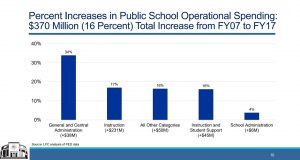Maximize Dollars to the Classroom
Issue Summary News Policy Report Take Action On This Issue
2023 Legislative Update
Think New Mexico drafted Senate Bill 438 which was introduced by Senators George Munoz, Crystal Diamond, and others to maximize the amount of the state’s education budget that is spent in the classroom, rather than on school district central administration.
For all school districts and charter schools with at least 2,000 students, Senate Bill 438 would limit the growth of school district central administrative spending to no faster than the overall growth in the state education budget. This means that if the legislature appropriates funding for a 7% increase in total state K-12 education spending, a school district would not be permitted to grow its central and general administrative spending faster than 7%.
An analysis by the Legislative Finance Committee (LFC) found between 2007-2019, school district spending on general and central administration grew by 55%, nearly three times faster than spending on instruction and student support, which grew by 19%-20%. Every dollar spent on general and central administration – which includes expenses like the superintendent’s office, business management, public information office, legal services, purchasing and distribution – is a dollar that is not available for the investments that most benefit children, including teachers, principals, counselors, nurses, coaches, and librarians.
Because one factor driving the growth of central administrative spending is the growth in state reporting requirements, the bill also laid out a strategy to identify and eliminate nonessential, redundant, and unnecessarily burdensome reporting requirements on school districts, with a goal of reducing the number of state reports by at least 25%. Unfortunately Senate Bill 438 did not receive a hearing, as it was opposed by the associations representing superintendents and school boards.
In order to continue to make progress with the part of the bill focused on reducing reporting requirements, we put that section of the bill into a new piece of legislation, Senate Joint Memorial 14, which was introduced by Senators Gay Kernan (R-Hobbs) and Martin Hickey (D-Albuquerque), who both serve on the Senate Education Committee. SJM 14 passed the Senate 36-0 on Thursday and the House unanimously on the final morning of the 2023 legislative session.
2022 Legislative Update
Think New Mexico supported Senate Bill 75, sponsored by Senators Bobby Gonzales and Shannon Pinto, to maximize the amount of the state’s education budget that is spent in the classroom, rather than on school district central administration.
An analysis by the Legislative Finance Committee (LFC) found that school district general and central administration grew by 34% from 2007-2017, more than twice as fast as all classroom spending, which increased by 16% during the same time period. Meanwhile, the funds allocated to principals’ offices increased by less than 4% over the past decade, even though principals have a far more significant impact on student outcomes than central office administrators.
The contrast was even starker a year later, after the large investments that you and the legislature made in 2019: between 2007-2019, the LFC found that general and central administration had grown by 55%, while instruction grew by 19%, instructional and student support by 20%, and principals’ offices by just 2%. According to Think New Mexico’s calculations, between 2006-2007 and 2016-2017, more than two-thirds of school districts across New Mexico (61 of 89) grew their central office administrative spending faster than their classroom spending.
Senate Bill 75 would limit the growth of school district central administrative spending to no faster than the Consumer Price Index (CPI) or the overall growth in the state education budget, whichever is lower. Classroom spending would not be limited. This means that in years like 2019, when lawmakers increased education spending by about 16% and the CPI was about 2%, central administration would be limited to 2% growth. All the rest of the new money would go to the classroom, where the learning takes place.
Governor Lujan Grisham added Senate Bill 75 to her legislative agenda, which allowed it to be heard during the 30-day session. Unfortunately, the lobbyists representing superintendents and school boards strongly opposed the bill, as it would rein in some of their spending authority, and as a result we did not have the votes to get Senate Bill 75 through the Senate Education Committee.
Instead, Think New Mexico worked with our legislative allies to pass Senate Memorial 30, which directs the Legislative Finance Committee, the budget arm of the legislature, to study why administrative spending has been outpacing classroom spending and recommend legislation to fix the problem in next year’s legislative session. The memorial passed on the final night of the 2022 session with a vote of 36-0, and it will help us lay the groundwork to advance this reform in 2023.
2019-2020 Legislative Update
During the 2019 legislative session, Representative Bobby Gonzales (D-Taos), former Superintendent of Taos Municipal Schools and Vice-Chair of the House Appropriations and Finance Committee, and Senator Jacob Candelaria (D-Albuquerque), introduced House Bill 77.
House Bill 77 proposed to limit the growth of school district central administrative spending to no faster than the Consumer Price Index (CPI) or the overall growth in the state education budget, whichever is lower. Classroom spending would not be limited. So in years like 2019, when lawmakers increased education spending by about 16% and the CPI is about 2%, central administration would be limited to 2% growth. All the rest of the new money would go to the classroom, where the learning takes place.
The Albuquerque Journal published an excellent editorial highlighting how the bill would help improve education in New Mexico. The Las Cruces Sun-News also published an editorial in support of House Bill 77, which ran in the Carlsbad Current-Argus and the Silver City Sun-News as well.
Although House Bill 77 did not pass, similar provisions were included in the state budget to maximize the amount of the 2019-2020 education budget that actually reaches students and teachers in the classroom, rather than going to central administration.
These budget provisions were also included in the 2020-2021 budget, in an even stronger form.
When Think New Mexico studied how New Mexico’s education dollars have been spent over the past decade, we discovered that between 2006-2007 and 2016-2017, more than two-thirds of school districts across New Mexico (61 of 89) grew their central office administrative spending faster than their classroom spending. (Read Think New Mexico’s full news release, and download the explanatory memo, classroom and administrative spending growth rates for school districts, for charter schools, and statewide. Please email us if you would like the full Excel sheet of all data).

As this chart from the legislature’s finance staff shows, school district general and central administration grew by 34% over the past decade, more than twice as fast as all classroom spending, which increased by 16% during the same time period. Meanwhile, the funds allocated to principals’ offices increased less than 4% over the past decade, even though principals have a far more significant impact on student outcomes than central office administrators.
Think New Mexico will continue working to make sure that the state’s education budget maximizes dollars to the classroom not only in the 2019-2020 budget year, but every year going forward.
Issue Summary
 New Mexico’s public schools present a riddle: why have our student outcomes remained stuck at the bottom of the nation even as our education spending has increased? Between 1993 and 2014, New Mexico rose from 44th in the nation to 36th in the nation for total annual spending per student, according to the National Center for Education Statistics. In 2017, the National Education Association, which represents teachers, ranked New Mexico second in the nation for spending on education per every $1,000 of personal income. Yet our graduation rates and math and reading scores continue to lag behind states that spend less per student.
New Mexico’s public schools present a riddle: why have our student outcomes remained stuck at the bottom of the nation even as our education spending has increased? Between 1993 and 2014, New Mexico rose from 44th in the nation to 36th in the nation for total annual spending per student, according to the National Center for Education Statistics. In 2017, the National Education Association, which represents teachers, ranked New Mexico second in the nation for spending on education per every $1,000 of personal income. Yet our graduation rates and math and reading scores continue to lag behind states that spend less per student.
One part of the reason is that only about 57.2% of New Mexico’s education budget is dedicated to instruction. While there is little to no correlation between total spending and student outcomes, there is a much stronger connection between the proportion of a state’s education budget dedicated to instruction and student performance in that state.
More evidence for this connection can be found in New Mexico’s highest performing school districts. Along with achieving high graduation rates and math and reading scores, these districts tend to spend a larger percentage of their budgets on classroom expenses, such as teachers, coaches, counselors, nurses, educational assistants, and school supplies, rather than on administrative expenses in the central district office.
Since about 90% of New Mexico’s operational education budget consists of state taxpayer dollars, the legislature and governor have the responsibility to ensure that the money is spent as effectively as possible.
Based on the examples of the state’s most successful districts, in 2017 Think New Mexico launched a new initiative recommending that the legislature and governor establish minimum percentages of each school district’s (and charter school’s) budget that must be spent in the classroom, rather than on administrative expenses. The minimum percentages would vary based on district size, as larger districts with better economies of scale should be able to spend a higher proportion of their budgets in the classroom. In addition, “classroom spending” would be broadly defined to include not only instruction, instructional support (e.g., librarians), and student support (e.g., counselors, nurses), but also principals, since the research suggests that principals can have a powerful positive impact on student achievement.
Think New Mexico identified specific strategies for achieving administrative savings that add up to over $100 million, including reducing unnecessary reporting burdens, cutting specific administrative costs, eliminating spending on public relations and hired lobbyists, and right-sizing underperforming districts.
If New Mexico were able to shift just 4% of its $2.7 billion from administration to the classroom, it would mean an increase of over $100 million for proven education reforms, from K-3 Plus to prekindergarten to better pay for principals and teachers.
Sign up for our email alerts and follow our Facebook and Twitter pages to stay informed and get involved on this issue!
2018 Legislative Update
A bipartisan team of legislators, including five educators and the Democratic Chair and ranking Republican on the House Appropriations and Finance Committee, introduced House Bill 180 to move more than $100 million a year from school district central administrative offices to New Mexico’s classrooms. Moving these dollars to the classroom would make more money available for critical needs like addressing the statewide teacher shortage and expanding access to proven programs like early childhood education and K-3 Plus.
The bill proposed ambitious but achievable targets for school districts and charter schools to maximize the percentage of their budgets that they are spending in the classroom. The targets were voluntary, and the bill proposed to help school districts and charter schools meet them by reducing unnecessary administrative paperwork.
Although the bill unfortunately did not pass during the 2018 legislative session, Think New Mexico continues to believe that more dollars in the classroom are urgently needed (as do the teachers who testified in favor of the bill and the hundreds of New Mexicans who wrote to their legislators asking them to support it). We worked throughout 2018 to revise our legislation and bring it back during the 2019 legislative session.
News Coverage
![]() Read our guest editorial about the need to maximize dollars to the classroom • March 2, 2023
Read our guest editorial about the need to maximize dollars to the classroom • March 2, 2023
![]() Read columnist Milan Simonich’s coverage in the Santa Fe New Mexican of an unsuccessful attempt to block a legislative memorial to study the growth of administrative costs in New Mexico school districts • May 15 & 17, 2022
Read columnist Milan Simonich’s coverage in the Santa Fe New Mexican of an unsuccessful attempt to block a legislative memorial to study the growth of administrative costs in New Mexico school districts • May 15 & 17, 2022
![]() Read an editorial by the Albuquerque Journal about the need to maximize dollars to the classroom • February 20, 2019
Read an editorial by the Albuquerque Journal about the need to maximize dollars to the classroom • February 20, 2019
![]() Read a opinion editorial by Executive Director Fred Nathan about the need to limit administrative spending and send more dollars to the classroom • January 27, 2019
Read a opinion editorial by Executive Director Fred Nathan about the need to limit administrative spending and send more dollars to the classroom • January 27, 2019
![]() Listen to KSFR 101.1 radio story on House Bill 77 • January 21, 2019 (mp3, 3:43)
Listen to KSFR 101.1 radio story on House Bill 77 • January 21, 2019 (mp3, 3:43)
![]() Read a Las Cruces Sun-News editorial about the benefits of House Bill 77 • January 11, 2019
Read a Las Cruces Sun-News editorial about the benefits of House Bill 77 • January 11, 2019
![]() Read an opinion editorial by Executive Director Fred Nathan about how the Yazzie decision makes it clear that New Mexico must spend more in the classroom • August 13, 2018
Read an opinion editorial by Executive Director Fred Nathan about how the Yazzie decision makes it clear that New Mexico must spend more in the classroom • August 13, 2018
![]() Read an opinion editorial by Executive Director Fred Nathan about Think New Mexico’s legislation to maximize dollars in the classroom • February 1, 2018
Read an opinion editorial by Executive Director Fred Nathan about Think New Mexico’s legislation to maximize dollars in the classroom • February 1, 2018
![]() Read a column by syndicated columnist Tom McDonald about Think New Mexico’s initiative to reallocate dollars from school district administration to the classroom • January 18, 2018
Read a column by syndicated columnist Tom McDonald about Think New Mexico’s initiative to reallocate dollars from school district administration to the classroom • January 18, 2018
![]() Read a Quay County Sun editorial supporting Think New Mexico’s initiative to reallocate dollars from school district administration to the classroom • October 18, 2017
Read a Quay County Sun editorial supporting Think New Mexico’s initiative to reallocate dollars from school district administration to the classroom • October 18, 2017
![]() Read an Albuquerque Journal editorial supporting Think New Mexico’s initiative to reallocate dollars from school district administration to the classroom • October 11, 2017
Read an Albuquerque Journal editorial supporting Think New Mexico’s initiative to reallocate dollars from school district administration to the classroom • October 11, 2017
![]() Read a Hobbs New Sun article about Think New Mexico’s initiative to reallocate dollars from school district administration to the classroom • October 18, 2017
Read a Hobbs New Sun article about Think New Mexico’s initiative to reallocate dollars from school district administration to the classroom • October 18, 2017
![]() Read an Eastern New Mexico News article about Think New Mexico’s initiative to reallocate dollars from school district administration to the classroom • October 26, 2017
Read an Eastern New Mexico News article about Think New Mexico’s initiative to reallocate dollars from school district administration to the classroom • October 26, 2017
![]() Read a Santa Fe New Mexican editorial on Think New Mexico’s initiative to maximize dollars to the classroom • October 11, 2017
Read a Santa Fe New Mexican editorial on Think New Mexico’s initiative to maximize dollars to the classroom • October 11, 2017
![]() Read an Truth or Consequences Herald article about Think New Mexico’s initiative to reallocate dollars from school district administration to the classroom • October 25, 2017
Read an Truth or Consequences Herald article about Think New Mexico’s initiative to reallocate dollars from school district administration to the classroom • October 25, 2017
![]() Read an Albuquerque Journal article describing Think New Mexico’s initiative to reallocate dollars from school district administration to the classroom • October 8, 2017
Read an Albuquerque Journal article describing Think New Mexico’s initiative to reallocate dollars from school district administration to the classroom • October 8, 2017
![]() Read Think New Mexico’s opinion editorial on moving resources from administration to the classroom • February 24, 2003
Read Think New Mexico’s opinion editorial on moving resources from administration to the classroom • February 24, 2003

